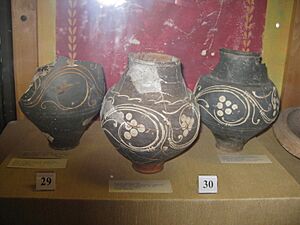Nene Valley Colour Coated Ware facts for kids

Imagine pottery made by people living in Britain when the Romans were in charge! That's what Nene Valley Colour Coated Ware is. It's also sometimes called Castor Ware. This special type of pottery was made in the lower Nene Valley in England. This area is near modern-day Peterborough.
It was made a long, long time ago, from the mid-2nd to the 4th centuries AD. That's about 1,800 years ago! You can see some of the best examples of this pottery in museums. Places like the British Museum and the Peterborough Museum have great collections. People often shorten its name to NVCC.
Contents
Pottery Making in the Nene Valley
Pottery making started in this area around the middle of the 1st century AD. Early workshops were near a Roman fort at Longthorpe, Peterborough. Over time, more pottery workshops appeared. They spread out for several miles along the Nene valley. This happened between Wansford and Peterborough in the 2nd century.
The main place for making this pottery was a Roman town called Durobrivae (Water Newton). However, kilns (special ovens for baking pottery) were found all over the area. These kilns were in places like Stibbington, Sibson-cum-Stibbington, Chesterton, Yaxley, and Stanground.
What the Pottery Looks Like
Nene Valley Colour Coated Ware is usually very strong and smooth. When it breaks, the edges are a bit uneven. The pottery itself is often white or off-white.
It has a special coating called a "slip." This slip can be dark brown or black. Sometimes it looks mottled, with lighter orange or orange-brown spots. This happens where the coating is thinner. If you look closely, you might see tiny bits of quartz sand inside the pottery. You might also spot small red, orange, or black flecks.
How the Pottery Was Decorated
The way NVCC pots were decorated is very unique. The most common shapes were beakers, which are like drinking cups. These beakers often had special rims or were shaped like bags.
The decorations were made using different techniques:
- Barbotine: This is like drawing with thick clay. The clay was squeezed onto the pot, either before or after the colored slip was added.
- Rouletting: This involved using a small wheel to create patterns. It made rows of tiny bumps or dots.
- Grooving: This was simply making lines or grooves in the pottery.
Early on, many pots showed exciting hunt scenes made with barbotine. You might see pictures of animals or hunters. Later, in the 3rd century AD, artists started using swirl patterns instead of hunt scenes.
Where to See Nene Valley Pottery
If you want to see collections of Nene Valley Colour Coated Ware, these museums have many pieces:
- British Museum in London
- Peterborough Museum in Peterborough
See also
- Nene Valley (disambiguation)
- List of Romano-British pottery


